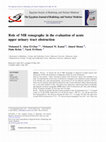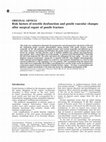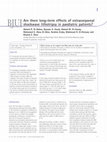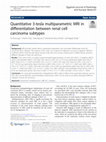Papers by Mohamed Abou El-Ghar
American Journal of Cancer Case Reports, 2015
Introduction: Primary adenocarcinoma of the seminal vesicle (SVC) is very rare. Presentation to ... more Introduction: Primary adenocarcinoma of the seminal vesicle (SVC) is very rare. Presentation to the case: Herein, we reported a case of SVA of SV cyst arising in a 51-year-old deaf mute male patient. Laboratory parameters including serum prostate specific antigen (PSA) level were normal. Contrast-enhanced magnetic resonance imaging demonstrated large reterovesical cystic lesion with mural nodules. The patient was managed by radical prostatectomy and seminovesiculolectomy. Microscopic examination revealed well-differentiated primary mucinous adenocarcinoma of left seminal vesicle cyst. Conclusion: To the best of our knowledge, this was the first case of SVA of SV cyst arising in deaf mute patient.

The Egyptian Journal of Radiology and Nuclear Medicine, 2011
To present the role of MR renography in diagnosis of upper urinary tract obstruction (UTO) with e... more To present the role of MR renography in diagnosis of upper urinary tract obstruction (UTO) with evaluation of diagnostic criteria for acute obstruction. Material and methods: Thirty consecutive patients with obstructive anuria were included in our study. For identification of the cause of obstruction, all patients were subjected to plain abdominal X-ray (KUB), gray scale ultrasonography, non-contrast CT for the abdomen and pelvis (NCCT). There were five patients with bilateral obstruction and 25 with obstructed solitary functioning kidney, so the study included 35 units. All patients were subjected to radioisotope diuretic renography and magnetic resonance renography (MRR) before relief of obstruction and 3 days after drainage. Of the 30 patients included, 20 were men and 10 women. Results: Among our patients the mean serum creatinine at time of presentation was 7 ± 4.5 mg/dl (range 2.4-12) and GFR ranged from 33 to 48 ml/min (mean ± SD; 38 ± 4.2). All the renal units have hydronephrosis. The mean pre drainage SI values 133 ± 22 (range 120-180). The mean time to peak (TP) for each unit was 171.6 ± 78 s and at isotope renography it was 320 ± 66 s. There was

Arab Journal of Urology, 2012
Objective: To evaluate the detectability, size, location and density of urinary stones with unenh... more Objective: To evaluate the detectability, size, location and density of urinary stones with unenhanced computed tomography (CT), using the half-radiation (low) dose (LDCT) technique, compared with the standard-dose CT (SDCT), in obese patients. Patients and methods: The study included 50 patients with a body mass index of >30 kg/m 2 and bilateral renal stones diagnosed with SDCT, and managed on one side. All the patients had LDCT during the follow-up and SDCT was used as a reference for comparison. Results: Of the 50 patients, the right side was affected in 27 and the left side in 23. In all, 35 patients had a single stone while the remaining 15 had multiple stones. With SDCT, 95 stones were detected; there were 45 of 65 mm, 46 of 6-15 mm and only four of >15 mm. LDCT barely detected three stones of <3 mm, compared with SDCT, while larger stones had the same appearance at both scans. The site of

The Scientific World JOURNAL, 2008
We conducted a prospective study to demonstrate the feasibility of using diffusionweighted (DW) m... more We conducted a prospective study to demonstrate the feasibility of using diffusionweighted (DW) magnetic resonance imaging (MRI) for the detection of urinary bladder carcinomas. Between January to June 2007, 43 patients with single bladder tumor were included in our study. Before taking a biopsy, DW MRI was obtained in the axial plane under free breathing scanning with a multisection, spin-echo type, single-shot echo planar sequence with a body coil. Moreover, the apparent diffusion coefficient (ADC) value was measured in a circular region of interest within the carcinoma, urine, normal bladder wall, prostate, and seminal vesicle. All carcinomas in the 43 patients were clearly shown as high signal intensity relative to the surrounding structure. The sensitivity and positive predictive values of DW MRI were 100% in terms of correctly detecting the carcinomas. The ADC value in the carcinoma (1.40 ± 0.51) was significantly lower compared with that of urine (3.50 ± 0.43) (p< 0.001), ...

Current Urology, 2011
Purpose: To assess efficacy, complications and long-term outcome of selective arterial embolizati... more Purpose: To assess efficacy, complications and long-term outcome of selective arterial embolization (SAE) for treatment of symptomatic giant angiomyolipoma larger than 10 cm. Materials and Methods: The surgical records of 9 patients with giant angiomyolipoma managed by SAE between 1990 and 2010 were reviewed. Results: The study included 4 men and 5 women, 5 of them (55.5%) had tuberous sclerosis complex. Indication for SAE was to stop severe hematuria in all patients. Among 9 patients, early complications occurred in 55.5% including post embolization syndrome in 1 patient, recurrent hematuria necessitating repeat embolization and nephrectomy in 3 and acute renal failure in 1 patient. During a mean follow-up of 2 years, 1 patient on hemodialysis was subjected to elective nephrectomy and 5 patients (55.5%) preserved their kidneys in whom radiology showed a decrease of size of the lesions by about 1/3 of its original size and all had a stable serum creatinine level. Conclusions: SAE of giant renal angiomyolipomas can be safely done to stop active bleeding in 2/3 of cases. Additional treatment may be necessary in 1/3 of patients and preservation of kidneys is amenable in 1/2 of cases.
The Scientific World JOURNAL, 2008
The ideal imaging modality should demonstrate the presence or absence of a clinically significant... more The ideal imaging modality should demonstrate the presence or absence of a clinically significant, causative vascular lesion that, in high-flow arterial priapism, may need intervention. We report a 22-year-old male with post-traumatic arterial priapism. Color Doppler ultrasound could not reliably identify a significant vascular lesion. Magnetic resonance angiography (MRA) demonstrated the presence of a cavernous artery pseudoaneurysm. Based on this finding, embolization was decided, with a successful outcome. Contrast-enhanced MRA appears to be a useful, noninvasive diagnostic tool for decision making in cases of high-flow priapism.
Reports in Medical Imaging, 2014

International Journal of Impotence Research, 2011
This study was conducted to determine the preoperative and intraoperative risk factors of ED and ... more This study was conducted to determine the preoperative and intraoperative risk factors of ED and the underlying penile vascular abnormalities among patients with penile fracture treated surgically. In all, 180 patients with penile fracture were treated surgically and followed up in one center. None of our patients had ED before the penile trauma and only two of them had risk factors for systemic vascular diseases, such as diabetes mellitus (one patient) and hypertension (one patient). After a mean follow-up of 106 months, 11 patients (6.6%) developed ED, 7 had mild ED and 4 had moderate ED. The main risk factors for subsequent ED were aging, 450 years, and bilateral corporal involvement. Among the 11 patients with ED, color Doppler ultrasonography (CDU) showed normal Doppler indices in 4 (36.4%), veno-occlusive dysfunction in 4 (36.4%) and arterial insufficiency in the remaining 3 (27.2%) patients. CDU assessments from the injured and intact sides were comparable. ED of either a psychological or vascular origin can be encountered as a long-term sequel of surgical treatment of penile fracture. Aging, 450 years, at presentation and bilateral corporal involvement is the main risk factors for subsequent development of ED.

BJU International, 2012
What ' s known on the subject? and What does the study add? Extracorporeal shockwave lithotripsy ... more What ' s known on the subject? and What does the study add? Extracorporeal shockwave lithotripsy is effective for the treatment of paediatric renal stones with favourable short-term safety. Extracorporeal shockwave lithotripsy for treatment of paediatric renal stones is also safe for the kidney and the child on long-term follow-up. • To evaluate the long-term effects of extracoporeal shockwave lithotripsy (SWL) for treatment of renal stones in paediatric patients. • A database of paediatric patients who underwent SWL monotherapy for treatment of renal stones from September 1990 through to January 2009 was compiled. This study included only patients with follow-up for more than 2 years. The long-term effects of SWL were evaluated at the last follow-up with measurement of patients ' arterial blood pressure, estimation of random blood sugar and urine analysis. The results of diastolic blood pressure were plotted against a standardized age reference curve. The treated kidney was examined by ultrasonography for measurement of renal length and detection of stones. The measured renal lengths were plotted against age-calculated normal renal lengths in healthy individuals. • The study included 70 patients (44 boys (63%) and 26 girls) with mean age at the time of SWL 6.5 ± 3.6 years (range 1 -14). The mean follow-up period was 5.2 ± 3.6 years (range 2.1 -17.5). The mean age at last follow-up was 11.7 ± 5.3 years (range 4.4 -27.5). No patients developed hypertension or diabetes. Only one treated kidney was smaller than one standard deviation of the calculated length. The cause of this was obstruction by a stone in the pelvic ureter 3 years after SWL. • The long-term follow-up after SWL for treatment of renal stones in paediatric patients showed no effect on renal growth and no development of hypertension or diabetes.

The British Journal of Radiology, 2012
The aim was to evaluate the effects of diagnostic performance of diffusionweighted (DW) MRI in th... more The aim was to evaluate the effects of diagnostic performance of diffusionweighted (DW) MRI in the assessment of acute impairment of transplanted kidneys. Methods: From January 2009 to January 2010, 49 patients with stable renal allograft function (Group 1) and 21 patients with acute graft impairment (Group 2) were included in the study. All patients were evaluated with coronal T 2 weighted (T 2 W) and DW MRI of the kidney. Patients in Group 2 underwent graft biopsy to determine the underlying histopathological aetiology. Apparent diffusion coefficient (ADC) was calculated and the kidneys were studied for any areas of diffusion restriction. Two radiologists, who were blinded to the results of histopathology, independently interpreted the T 2 W and DW images. Results: The histopathological diagnosis ofGroup 2 (21 patients) was acute cellular rejection (ACR) in 10, acute tubular necrosis (ATN) in 7 and immunosuppressive toxicity in 4 patients. ADC values in Group 1 were significantly higher compared with Group 2 (p,0.001), patients with ACR (p,0.001), patients with ATN (p,0.001) and patients with drug toxicity (p,0.001). Using 2610 23 mm 2 s 21 as a cut-off, there was no overlap between the ADC values of patients with normal graft function and those with ATN. Both ACR and ATN had a low ADC value, but on the ADC map the kidney in cases of ATN appears heterogeneous with a characteristic mosaic pattern resembling the Tiger skin. There was no significant T 2 W morphological difference between the two groups. Conclusion: These results show how DW MRI is a promising new technique for the diagnosis of acute renal transplant dysfunction.

Cancers
Globally, renal cancer (RC) is the 10th most common cancer among men and women. The new era of ar... more Globally, renal cancer (RC) is the 10th most common cancer among men and women. The new era of artificial intelligence (AI) and radiomics have allowed the development of AI-based computer-aided diagnostic/prediction (AI-based CAD/CAP) systems, which have shown promise for the diagnosis of RC (i.e., subtyping, grading, and staging) and prediction of clinical outcomes at an early stage. This will absolutely help reduce diagnosis time, enhance diagnostic abilities, reduce invasiveness, and provide guidance for appropriate management procedures to avoid the burden of unresponsive treatment plans. This survey mainly has three primary aims. The first aim is to highlight the most recent technical diagnostic studies developed in the last decade, with their findings and limitations, that have taken the advantages of AI and radiomic markers derived from either computed tomography (CT) or magnetic resonance (MR) images to develop AI-based CAD systems for accurate diagnosis of renal tumors at a...

2018 25th IEEE International Conference on Image Processing (ICIP), 2018
Recently, diffusion-weighted magnetic resonance imaging (DW-MRI) has been explored for non-invasi... more Recently, diffusion-weighted magnetic resonance imaging (DW-MRI) has been explored for non-invasive assessment of renal transplant functions. In this paper, a computer-aided diagnostic (CAD) system is developed to assess renal transplant functionality, which integrates both clinical and diffusion MRI -derived markers extracted from 4D DW-MRI (i.e. 3D + b-value). To extract the DW-MR image-markers, our framework performs multiple image processing steps, including kidney segmentation using a level-set approach and estimation of image-markers. To extract these image-markers, apparent diffusion coefficients (ADCs) are estimated from the segmented DW-MRIs and cumulative distribution functions (CDFs) of the ADCs are constructed at different b-values (i.e. gradient field strengths and duration). Finally, these markers (i.e. CDFs) are integrated with clinical biomarkers (e.g., creatinine clearance and serum plasma creatinine) to assess transplant status using stacked auto-encoders with non-...

State of the Art in Neural Networks and their Applications, 2021
Abstract The goal of this chapter is to explore the developed computer-aided diagnostic (CAD) sys... more Abstract The goal of this chapter is to explore the developed computer-aided diagnostic (CAD) system that helps to determine the functionality of renal transplant using diffusion-weighted magnetic resonance imaging (DW-MRI). This study is based on the integration of DW-MRI-based biomarkers with clinical-based biomarkers. The data are acquired at different durations and strengths of the magnetic field (b-values). The DW-MRI data were collected from Egypt and the United States, using different scanners such as GE and Philips. Using a level-set approach, the kidney is first segmented, then estimates the apparent diffusion coefficients (ADCs). Then serum creatinine and creatinine clearance (the clinical biomarkers that we used) are combined with the ADCs, creating new image markers known as integrated ADCs (IADCs). Finally, the IADCs make cumulative distribution functions at the different b-values. Lastly, any classifier may be used to distinguish between nonrejection and acute rejection renal transplant status. More importantly, our proposed CAD system exhibits 93% accuracy, 93% sensitivity, and 92% specificity in distinguishing between the renal transplant status. This concluded that the developed CAD system is completely independent of classifiers, geographical areas, and scanner type. These results support that the developed CAD system might be noninvasively able to assess the status of renal allograft dysfunction.

Egyptian Journal of Radiology and Nuclear Medicine, 2021
Background MRI provides several distinct quantitative parameters that may better differentiate re... more Background MRI provides several distinct quantitative parameters that may better differentiate renal cell carcinoma (RCC) subtypes. The purpose of the study is to evaluate the diagnostic accuracy of apparent diffusion coefficient (ADC), chemical shift signal intensity index (SII), and contrast enhancement in differentiation between different subtypes of renal cell carcinoma. Results There were 63 RCC as regard surgical histopathological analysis: 43 clear cell (ccRCC), 12 papillary (pRCC), and 8 chromophobe (cbRCC). The mean ADC ratio for ccRCC (0.75 ± 0.13) was significantly higher than that of pRCC (0.46 ± 0.12, P < 0.001) and cbRCC (0.41 ± 0.15, P < 0.001). The mean ADC value for ccRCC (1.56 ± 0.27 × 10−3 mm2/s) was significantly higher than that of pRCC (0.96 ± 0.25 × 10−3 mm2/s, P < 0.001) and cbRCC (0.89 ± 0.29 × 10−3 mm2/s, P < 0.001). The mean SII of pRCC (1.49 ± 0.04) was significantly higher than that of ccRCC (0.93 ± 0.01, P < 0.001) and cbRCC (1.01 ± 0.16,...

2017 IEEE 14th International Symposium on Biomedical Imaging (ISBI 2017), 2017
In recent years, magnetic resonance imaging (MRI) has been explored for non-invasive assessment o... more In recent years, magnetic resonance imaging (MRI) has been explored for non-invasive assessment of renal transplant function. This paper proposes a computer-aided diagnostic (CAD) system for the assessment of renal transplant status, which integrates both clinical and MRI-derived biomarkers. The latter are derived from either 3D (2D + time) dynamic contrast-enhanced MRI or 4D (3D + b-value) diffusion-weighted (DW) MRI. In order to extract the MRI-based biomarkers, our framework performs multiple image processing steps, including MRI data alignment to handle the motion effects, kidney segmentation using a geometric deformable model, local motion correction, and estimation of image-based biomarkers. These biomarkers are fused with clinical biomarkers (creatinine clearance and serum plasma creatinine) for the classification of transplant status using a machine learning classifier. Our CAD system has been tested on a cohort of 100 subjects (50 DCE-MRI and 50 DW-MRI) using a “leave-one-subject-out” approach and distinguished rejection from non-rejection transplants with an overall accuracy of 98% for both DCE-MRI and DW-MRI data sets. These preliminary results demonstrate the promise of the proposed CAD system as a reliable non-invasive diagnostic tool for renal transplant assessment.
Biomedical Image Segmentation, 2016

2018 IEEE International Conference on Imaging Systems and Techniques (IST), 2018
The goal of this paper is to determine the parameters that are correlated with the biopsy diagnos... more The goal of this paper is to determine the parameters that are correlated with the biopsy diagnosis of acute renal rejection (AR) post-transplantation, using laboratory biomarkers and (3D+ -value) diffusion weighted MR (DW-MR) image- markers. 16 patients with non-rejection (NR) and 45 patients with AR renal allografts determined by their renal biopsy as a gold standard were included. All kidneys were evaluated using both laboratory biomarkers (e.g., creatinine clearance (CrCl) and serum creatinine (SCr)) and DW-MR image-markers. To extract the latter, DW-MR kidney images were first segmented using a geometric deformable model, then, DW-MR image-markers known as apparent diffusion coefficients (ADCs), were estimated for segmented kidneys at multiple b-values (i.e. strength and timing, of, the, field, gradients, (b50,b 100,,…,b 1000 s/mm2)). A statistical analysis investigating possible correlations between potential biomarkers of AR and the biopsy diagnosis was firstly performed. Two...

2019 IEEE International Conference on Image Processing (ICIP), 2019
Non-invasive evaluation of renal transplant function is essential to minimize and manage acute re... more Non-invasive evaluation of renal transplant function is essential to minimize and manage acute renal rejection (AR). A computer-assisted diagnostic (CAD) system is developed to evaluate kidney function post-transplantation. The developed CAD system utilizes the amount of blood-oxygenation extracted from 3D (2D + time) blood oxygen level-dependent magnetic resonance imaging (BOLD-MRI) to estimate renal function. BOLD-MRI scans were acquired at five different echo-times (2, 7, 12, 17, and 22) ms from 15 transplant patients. The developed CAD system first segments kidneys using the level-sets method followed by estimation of the amount of deoxyhemoglobin, also known as apparent relaxation rate (R2*). These R2* estimates are used as discriminatory features (global features (mean R2*) and local features (pixel-wise R2*)) to train and test state-of-the-art machine learning classifiers to differentiate between non-rejection (NR) and AR. Using a leave-one-out cross-validation approach along...
Diffusion-weighted magnetic resonance imaging (DW-MRI) is a promising noninvasive technique that ... more Diffusion-weighted magnetic resonance imaging (DW-MRI) is a promising noninvasive technique that provides qualitative and quantitative information of tissue cellularity and the integrity of cellular membranes. DWI has a large number of potential clinical applications in the evaluation of urinary tract especially in the field of oncology. Addition of DWI to conventional MRI sequences can address many of the diagnostic problems, like detection of small lesions and differentiating recurrent lesions from postoperative inflammatory changes. DWI improves tumor staging by MRI that has a great impact on patient’s management. DWI can be used in monitoring of tumor response to chemoradiotherapy; it can detect early changes in tumor metabolism and microstructural changes that can be detected by changes in the apparent diffusion coefficient (ADC) of the lesions.

Uploads
Papers by Mohamed Abou El-Ghar